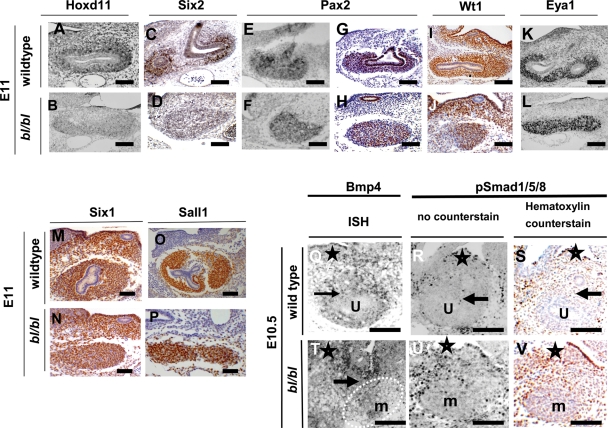Figure 5.
Expression of transcription factors and Bmp4. (A)–(P) are sections from E11 animals when, in wild types, the UB has undergone one round of branching within the MM. (Q)–(V) are E10.5 embryos, where the wild-type UB had just penetrated the MM. Positive expression signals are black in (A), (B), (E), (F), (K), (L), (Q), (R), (T) and (U); in other frames, positive IHC signals are brown. (C), (D), (G)–(J), (M)–(P), (S) and (V) were counterstained with haematoxylin. (A) and (B) ISH for Hoxd11 and (C) and (D) IHC for Six2 showing downregulated expression in bl/bl MMs. (E)–(P) Several other genes showed similar intensity of signal in wild-type and mutant MMs: Pax2 ISH [(E) and (F)]; Pax2 IHC [(G) and (H)]; Wt1 IHC [(I) and (J)]; Eya1 ISH [(K) and (L)]; Six1 IHC [(M) and (N)]; Sall1 IHC [(O) and (P)]. (Q)–(V) Bmp4 ISH depicted in (Q) and (T), whereas other frames are IHC for phospho-Smad1/5/8. Note that (S) and (V), respectively, are frames (R) and (U) counterstained with haematoxylin. In wild-types, Bmp4 transcripts were detected around UB stalks, with weak signal for phospho-Smad1/5/8 in this location. In bl/bl littermates, Bmp4-expressing cells were detected between the MM and unbranched MD, with several cell layers expressing phospho-Smad1/5/8 in this location. Stars have been placed next to MDs, and arrows indicate normal UB stalk in wild types and an abnormal UB stump in the bl/bl embryo; in the wild-type frames, ‘u’ indicates the UB within the MM and, in the bl/bl fames, ‘m’ indicates the un-penetrated MM. Bars in all frames are 100 µm.

